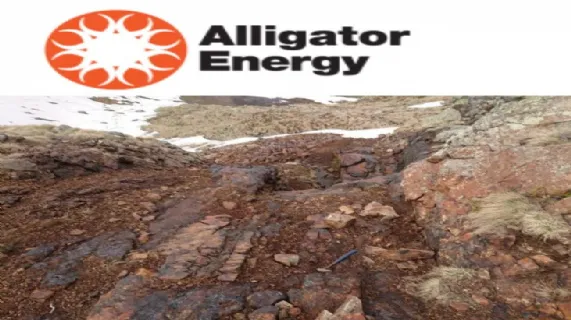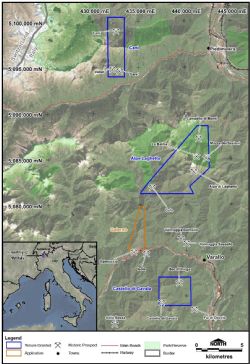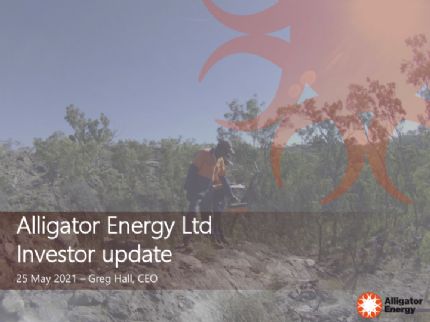
First Piedmont Assays Confirm Significant Ni Co Mineralisation with Grades up to 2.5% Ni and 0.17% Co.
Brisbane, July 26, 2018 AEST (ABN Newswire) - Alligator Energy Limited ( ASX:AGE) (Alligator or the Company) is pleased to release the first batch of assay results received from its detailed on-ground geochemical sampling and mapping work at its Piedmont nickel-cobalt-copper project in northern Italy. The Piedmont Project is a farm-in/joint venture arrangement with Chris Reindler and Partners (CRP) (ASX Announcement: 1 February 2018).
ASX:AGE) (Alligator or the Company) is pleased to release the first batch of assay results received from its detailed on-ground geochemical sampling and mapping work at its Piedmont nickel-cobalt-copper project in northern Italy. The Piedmont Project is a farm-in/joint venture arrangement with Chris Reindler and Partners (CRP) (ASX Announcement: 1 February 2018).
Highlights
Significant geochemical rock chip sample assays include:
Alpe Laghetto
Sample P18-S053 - 1.56% Ni, 0.13% Co, 0.10% Cu
Sample P18-S059 - 1.36% Ni, 0.13% Co, 0.09% Cu
Sample P18-S015 - 0.19% Ni, 0.02% Co, 0.98% Cu
Alpe Cevia
Sample P18-S003 - 2.48% Ni, 0.17% Co, 0.13% Cu
Sample P18-S080 - 1.57% Ni, 0.11% Co, 0.07% Cu
La Balma
Sample P18-S027 - 1.03% Ni, 0.10% Co, 0.08% Cu
Sample P18-S026 - 0.29% Ni, 0.03% Co, 0.72% Cu
Sample P18-S025 - 0.97% Ni, 0.08% Co, 0.12% Cu
- Range of significant metal grades from sampling of 0.19 to 2.48% Ni, 0.02 to 0.17% Co and 0.07 to 0.98% Cu;
- Detailed on-ground mapping and sampling of the first selected target area has verified massive sulphide mineralisation intermittently outcropping over a 2 to 3km strike length with thicknesses ranging from 1 to 4 metres;
- A magnetometer is now being trialled to test its ability to detect mineralisation continuity at depth as weakly magnetic pyrrhotite is seen often associated with the mineralisation;
- The presence of a large mafic/ultramafic layered complex approximately 30kms long by 2-3kms wide which contains known massive sulphide mineralisation, historical mine workings, and potential for further discoveries has been confirmed through outcrop mapping;
- Alligator's Ni Co Competent Person has visited site and reviewed and inspected the Piedmont exploration work.
Since 11 May 2018, AGE's exploration team, comprising AGE exploration management, project and local geologists, have completed substantial on-ground geological and structural mapping along with extensive geochemical sampling, both in and around the historical mines located within the project area. A working exploration base has been established at the nearby town of Varallo, some 10kms away.
AGE's CEO Greg Hall commented today: "These first assay results have verified that we are looking at significant nickel-cobalt-copper mineralisation within an extensive system. We will await further assay results, and in the meantime are continuing with on ground geophysics work testing mineralisation continuity".
Geological Setting and Exploration progress
A review of historical results and technical papers, combined with on-ground observation, indicate the region is a major gabbroic mafic complex, with sub-volcanic layered intrusive structures leading down to depth. The region of interest appears to extend some 30kms in length, by 2 to 3kms wide. From previous work, the dominant sulphide mineral is pyrrhotite, with minor amounts of pentlandite and chalcopyrite.
Phase One exploration work to date has included the collection of 165 surface rock chip samples from within the current licence area, of which 72 sample assay results have been received to date. The remaining results are expected before the end of August. A further 12 samples have been collected for petrographic studies.
Of the 165 samples collected to date, 159 are located within the Alpe Laghetto licence area. Figure 1 in link below shows the distribution of all samples collected to date and assays received over the Alpe Laghetto licence area plotted by Ni %. Three prospects have returned results >1% Ni within this first batch of results, being Alpe Cevia, Alpe Laghetto and La Balma.
The latter two of these prospects form a north-south La Balma-Laghetto trend of intermittently outcropping mineralisation over a 2 to 3km strike length, showing geological similarities and structural connections. Mineral prospectivity occurs along the strike length of the trend, with structural and / or other influences forming mineralised lenses of varying thicknesses. Work is continuing to determine the level of continuity and structural setting of the lenses.
The La Balma-Laghetto trend may also be extended by promising values at the Laghetto South prospect, with sample P18-S075 showing 0.87% Ni and 0.06% Co, as well as metal indications to the north of La Balma with the trend extending potentially to the old Campello Monti mine, the largest historical producer in this area. In total 19 of the 72 assays received to date have Ni results >0.5% and a further 2 samples with >0.7% Cu, a total of 21 highly anomalous rock chips from first pass reconnaissance sampling. Even more promising is the strong Cobalt credentials associating with higher Ni percentages from this initial sampling. Table 1 in link below shows results for these samples.
Geological mapping has indicated the potential for lateral and vertical extent of mineralisation. The indicative grade recorded in the rock chip sampling to date is seen as favourable.
The surface zone which lies above the originally identified EM anomaly appears to contain major late stage faulting and some associated graphite as determined from initial on-ground reconnaissance. The area is steep and is mostly covered by a scree slope. It is uncertain whether the EM anomaly is attributed to the graphitic horizon and structure identified or whether there is a deeper target potential. Some limited samples have been taken from this structure, results for which are expected in the second phase of assays. If it is determined that the EM anomaly is a deeper target this will likely require future drilling.
A variety of geophysical methods have been reviewed to assist with sulphide mapping. An initial ground magnetics trial is currently underway, the results and effectiveness of which will be assessed before further surveys are undertaken. This work will also assist to identify potential drill targets and sites to initiate Phase 2 of the farm-in program. Due to the identification of graphite in the region from on-ground reconnaissance it is believed ground magnetics will provide a truer indication of the mainly pyrrhotite mineralisation continuity than ground EM.
Six samples have also been taken on the Cani licence area to the north, distributions for which are not shown in this release with results not due until late August. An overview of project tenures can be seen below in Figure 2 (see link below).
Samples were selected on a geological basis and collected as grab samples in a non-systematic nature as part of a reconnaissance mapping program around historic nickel prospects and mines within AGE/CRP tenure. Sampling was completed using a geopick, with locations recorded utilising a hand held GPS. The program was designed to be representative of the variety of rock types and sulphide levels observed in the project area. Results are comparable to the previously unverified historic mining grades of the district and provide encouragement that, along with identification of lateral and depth continuation, potential exists for economic discoveries to be made within the district.
Project Background
The Piedmont Project is located within an historic mining district with cobalt, nickel and copper mining taking place from the late 1800's to the end of WWII. Cobalt production grades of over 0.2% and nickel grades of over 2% were recorded as historic mine grade estimates within the Project area.
Alligator considers the Piedmont project prospective for Fe-Ni-Cu-Co massive sulphide deposits in gabbroic and mafic rocks. Previous work on the metallogenesis of the Hercynian orogeny of the Alps completed by Omenetto and Brigo in 1974 drew strong similarities with Sudbury type ores regarding the sulphide assemblages. Bigioggero et al. 1979 made a division of the deposits within the project area based on the metal association and geological settings, these categories were:
1) Mineralisation in layers of the cyclic units, proximal to metasediments
2) Mineralisation in layers of the main gabbro
3) Mineralisation in pipes
Alligator are exploring for all 3 mineralisation types. Virtually no modern exploration has been completed within the district, until a recent EM survey highlighted targets proximal to historic workings.
Piedmont Project Deal Structure
Alligator entered a Binding Heads of Agreement with CRP on January 31st to earn into the Piedmont Cobalt Nickel project (see AGE ASX Press Release 1 February 2018). In summary, Alligators farm-in agreement comprises:
- Up-front payments in shares and cash
- A total of $650,000 to achieve 51% project ownership from both Phase 1 and 2
- Option to increase ownership to 70% through a further $1.25 million program of work
Alligator and CRP have agreed to collaborate on other Ni, Co, Cu opportunities within Italy as deemed suitable to both parties.
Alligator has now completed the establishment of an Italian company AGE EV Metals S.r.L. This company is a fully owned subsidiary of Alligator and will contain both the targeted 51% of the Piedmont Project (when earned) and any other additional opportunities which may be identified within the region.
To view tables and figures, please visit:
http://abnnewswire.net/lnk/3G0O4P01
About Alligator Energy Ltd
 Alligator Energy Ltd (ASX:AGE) is an Australian, ASX-listed, exploration company focused on uranium and energy related minerals, principally cobalt-nickel.
Alligator Energy Ltd (ASX:AGE) is an Australian, ASX-listed, exploration company focused on uranium and energy related minerals, principally cobalt-nickel.
Alligator's Directors have significant experience in the exploration, development and operations of both uranium and nickel projects (both laterites and sulphides).
| ||
|










